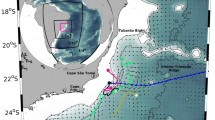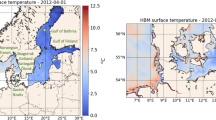Abstract
A sequential updating method for assimilating Geosat altimeter data into an eddyresolving, quasi-geostrophic model is examined using simulated data of mesoscale features taken from a control run solution. The upper-layer streamfunction in the model is updated by the “altimeter” data on satellite tracks (at ∼110 km intervals) at times of observations (with 17-day cycles). To evaluate data suitability, the correlation between the data and the assimilation solution just before update is compared with the correlation between the two data with a 1-cycle separation: i.e., predictability is compared with persistence. The assimilation method is tested on mesoscale features such as linear Rossby waves, unstable mesoscale meanders in a jet and dipole eddies over realistic deep ocean topography. The assimilation method is successful for reconstructing the mesoscale features that evolve gradually or extend over more than one track. Assimilation is degraded by quick evolution of smaller scale features; i.e the unstable meanders that have short wavelengths and are not well captured by the altimeter with the low cross-track resolution, and the mesoscale features, whose lower layer component receives effects of bottom topography in the data but is underestimated due to inefficient downward transfer of the surface data in the assimilation.
Similar content being viewed by others
References
Clarke, A. J. and K. H. Brink (1985): The response of stratified frictional flow of shelf and slope waters to fluctuating large-scale, low-frequency wind forcing.J. Phys. Oceanogr.,15, 439–453.
De Mey, P. and A. R. Robinson (1987): Assimilation of altimeter eddy field in a limited-area quasi-geostrophic model.J. Phys. Oceanogr.,17, 2280–2293.
Ghil, M. and P. Malanotte-Rizzoli (1991): Data assimilation in meteorology and oceanography.Adv. Geophys.,11, 141–266.
Grant, A. B. (1968): Atlas of oceanographic section. Report A.O.I. 68-5. Bedford Institute of Oceanography, Dartmouth, N.S.
Haines, K. (1991): A direct method for assimilating sea surface height data into ocean models with adjustments to the deep circulation.J. Phys. Oceanogr.,21, 843–868.
Holland, W. R. and P. Malanotte-Rizzoli (1989): Assimilation of altimeter data into an ocean model: space verses time resolution studies.J. Phys. Oceanogr.,19, 1507–1534.
Hurlburt, H. E. (1986): Dynamic transfer of simulated altimeter data into subsurface information by a numerical ocean model.J. Geophys. Res.,91, 2372–2400.
Ikeda, M. and J. R. Apel (1981): Mesoscale eddies detached from spatially growing meanders in an eastward-flowing oceanic jet using a two-layer quasi-geostrophic model.J. Phys. Oceanogr.,11, 1638–1661.
Kelly, K. A. (1991): The meandering Gulf Stream as seen by the Geosat altimeter: Surface transport, position and velocity variance from 73° to 46°W.J. Geophys. Res.,96, 16721–16738.
Kindle, J. C. (1986): Sampling strategies and model assimilation of altimetric data for ocean monitoring and prediction.J. Geophys. Res.,91, 2418–2432.
Le Traon, P. Y. (1991): Time scales of mesoscale variability and their relationship with space scales in the North Atlantic.J. Mar. Res.,49, 467–492.
Le Traon, P. Y., M. C. Rouquet and C. Boissier (1990): Spatial scales of mesoscale variability in the North Atlantic as deduced from Geosat data.J. Geophys. Res.,95, 20267–20285.
Mellor, G. L. and T. Ezer (1991): A Gulf Stream model and an altimetry assimilation scheme.J. Geophys. Res.,96, 8779–8795.
Tai, C.-K. (1990): Estimating the surface transport of meandering oceanic jet streams from satellite altimetry: surface transport estimates for the Gulf Stream and Kuroshio extension.J. Phys. Oceanogr.,20, 860–879.
Webb, D. J. and A. Moore (1986): Assimilation of altimeter data into ocean models.J. Phys. Oceanogr.,16, 1901–1913.
White, W. B., C.-K. Tai and W. R. Holland (1990a): Continuous assimilation of Geosat altimetric sea level observations into a numerical synoptic ocean model of the California Current.J. Geophys. Res.,95, 3127–3148.
White, W. B., C.-K. Tai and W. R. Holland (1990b): Continuous assimilation of simulated Geosat altimetric sea level into an eddy-resolving numerical ocean model. 1. Sea level differences.J. Geophys. Res.,95, 3219–3234.
Zlotnicki, V., L.-L. Fu and W. Patzert (1989): Seasonal variability in global sea level observed with Geosat altimetry.J. Geophys. Res.,94, 17959–17969.
Author information
Authors and Affiliations
Rights and permissions
About this article
Cite this article
Ikeda, M. Sequential updating assimilation of simulated Geosat altimeter data from mesoscale features into a two-layer quasi-geostrophic model. J Oceanogr 49, 697–718 (1993). https://doi.org/10.1007/BF02276753
Received:
Revised:
Accepted:
Issue Date:
DOI: https://doi.org/10.1007/BF02276753




